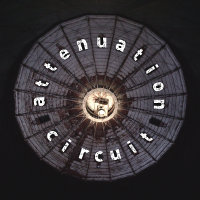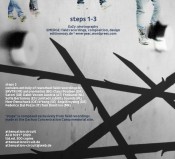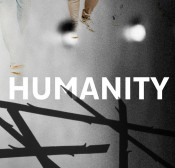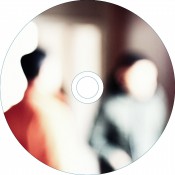steps
by EMERGE
What is it that we're hearing? Is it the wind? Is it the sea? Is it the crackle of a burning fire? Where are we? A great sense of loneliness pervades the quiet setting which we cannot quite make out. And then suddenly living creatures enter the sonic scene. Birds and people, their voices and their steps. They seem to be walking, walking past us, towards a destination we do not know. We cannot understand in what language or languages they are speaking – or can we? It is hard to make out, because everything they say is strangely muffled, although they are not speaking in a low voice. Everything we hear feels either too loud or too quiet, too close or too distant. As if some shock had happened to our hearing before we started listening to this album. Like a bomb exploding in close proximity to our ears. Or something so unimaginably terrible that it bent the acoustic space in the place from which these sounds come through to us. This is how the album “steps” begins.
The album “steps” is composed exclusively from field recordings made at the Dachau Concentration Camp memorial site. It is not possible to represent the horrors of concentration camps in music, and – a lesson learned from the many failures in the history of “industrial music” – the attempt to do so will inevitably result in trivialising kitsch, at best. Therefore, the album “steps” does not claim to be an album “about” a concentration camp, it is an album about a memorial site. Like the modern-day classic on the subject, “Gurs. Drancy. Gare de Bobigny. Auschwitz. Birkenau. Chelmo-Kulmhof. Majdaneck. Sobibor. Treblinka” by Stéphane Garin & Sylvestre Gobart (2011), “steps” goes to show to what extent contextual information about the sonic subject matter of a piece influences our listening. This artistic strategy can also be read in political terms: Only if we know the history behind these sounds – and the history of the place where they were recorded – are we able to make sense of the present.
For part 2, EMERGE invited sound artists from all over Europe to give their characteristic processing to the original audio field recordings. The resulting audio fragments are fed into the performance, symbolising a peaceful, solidary encounter of cultures – in deliberate contrast to the fact that people from many European countries were brought together in the Dachau concentration camp by utmost force.
File under: electroacoustic music, field recordings
ACU 1021
factory-pressed CD in Digisleeve
Released in 2020
limited to 300 copies
price: 13.00 EUR (excl. postage)
"steps" is an audiovisual project by EMERGE & EaZy
EaZy: photography
EMERGE: field recordings, composition, design
editioneazy.de
emergeac.wordpress.com
immerge.bandcamp.com
facebook.com/EazyEmerge
video teaser:
bit.ly/3bAJuPV
steps 2 consists entirely of reworked field recordings by:
SRVTR (FR)
srvtr.bandcamp.com
autonomaton (BG)
soundcloud.com/autonomaton
Claus Poulsen (DK)
clauspoulsen.com
Satori (GB)
satori-industrial.bandcamp.com
Dabit Vocem Austria (AT)
soundcloud.com/dabitvocemaustria
Freiband (NL)
fransdewaard.com
Sofia Bertomeu (ES)
sofiabertomeu.bandcamp.com
Limited Liability Sounds (PL)
llsnoise.pl
Herr Penschuck (DE)
herrpenschuck.eu
b°tong (SE)
btongmusic.com
Anja Kreysing (DE)
anjakreysing.de
Federico Dal Pozzo (IT)
soundcloud.com/federicodalpozzo
Toni Dimitrov (MK)
post-global.com
“steps” is composed exclusively from field recordings made at the Dachau Concentration Camp memorial site.
Also available here: http://www.discogs.com/seller/dependenz?sort=price&sort_order=asc&q=attenuation+circuit&st
PROGRESS REPORT
Albums of field recordings present us with sounds that are familiar. They ground the music in reality. A place where music doesn’t usually bother to exist. Pop, rock, hip-hop, etc, etc, may be set in the real world, but their music rarely lives there. Footsteps on concrete. Doors opening. Birds. The Wind. These are things we all know and recognise. Through layering, however, -EMERGE- has created something singular that has the power to repulse as much as it does entertain. Much of the album’s charm is down to your engagement. If you press play on this album and go about your day not really thinking about it then ‘Steps’ has a somewhat droney field recording vibe, but if you read a bit about the creation of the album, where it was recorded then it takes on a totally different meaning.
In a way it is pointless to try and describe what happens during each track. They don’t work that way. There are no real melodies to initially grab on it. No vocal hooks that explain what -EMERGE- is trying to express. Instead we are presented with three longform 10-22-minute-long pieces that contain droney atmospherics, echoey footsteps, the sounds of nature, church bells and mumbled voices. At times it feels like the sound design for an open world computer game set in a cavernous underground facility. The tracks have a haunting vibe to them, but -EMERGE- never dwells long enough on something for us to get an actual handle on what the original source recording was. Instead they are layered to create a lurid soundscape from another, slightly broody, place.
The haunting nature comes down to where the album was originally recorded. Recording an album like this at Dachau gives it a double edge sword. On one hand these recordings could have been made anywhere, in all fairness, and manipulated in a way to create similar results, but knowing that when we hear the sounds of feet moving/shuffling about they were recorded in a concentration camp gives them another, possibly, deeper meaning. This is ingrained in our psyche. We’ve all seen the footage of malnourished prisoners shuffling about. When hearing noises that tap into this ‘Steps’ really comes into its own. ‘Steps’ isn’t a time capsule. It isn’t a realistic, or authentic, picture of Dachau, but it does offer us another insight to it. NR
http://www.progress-report.co.uk/Reviews/E/-Emerge-.htm
NIEUWE NOTEN
‘Steps’ bestaat geheel uit veldopnames. De opnames die we horen in de delen één en drie maakte Stadlmeier zelf, voor deel 2 vroeg hij collega musici actief in de elektronische muziek als SRVTR, ofwel de Fransman Gildas Brugaro; Autonomaton, de Bulgaar Nikolay Ivanov Stanchev; de Deen Claus Poulsen, de Brit Dave Kirby die werkt onder het alias Satori en Frans de Waard. Al die opnames hebben één ding met elkaar gemeen: ze werden door de diverse artiesten gemaakt in het voormalige nazi concentratiekamp Dachau. Belangrijk is wat de musicus zelf zegt over zijn intenties achter dit album: “Das Album “steps” maßt sich jedoch gar nicht an, ein Album “über” ein Konzentrationslager zu sein. Es ist ausdrücklich ein Album über eine Gedenkstätte.” Terecht, want de gruwelen van een kamp zijn in muziek amper te vatten. Na het ruisen van de wind, horen we in ‘Steps 1’ de eerste voetstappen, knarsend in het grind. En ja, de vogels, niet wetend wat zich daar heeft afgespeeld. We horen mensen praten, verstaan niet wat ze zeggen. Allemaal geluiden die op enig moment worden afgewisseld met ritmische slagen op metaal. De mens is overduidelijk aanwezig in deze opnames, maar de natuur is dat evenzo, bijvoorbeeld in het geluid van de wind – er klappert iets – en dat van de vogels. Stadlmeier plakte al die geluiden aaneen tot een boeiende en soms ook enigszins beladen compositie. Het procedé voor de delen twee en drie is nagenoeg hetzelfde, ook hier past de aanduiding ‘klankcollage’ naadloos. Waarbij het derde deel overigens het meest dramatisch klinkt, onder andere door het gebeier van een klok en het onweer dat klinkt in de verte.
https://www.nieuwenoten.nl/?p=9240
VITAL WEEKLY
Label boss EMERGE is a very active musician when it comes to playing concerts and doing releases with recordings of those concerts. This is one of his rare studio recordings. It all started with inviting a bunch of friends to rework some field recordings into bits of sounds Emerge could use in a new project, but no-one (Limited Liability Sounds, Claus Poulsen, Herr Penschunck, B*tong among others) knew where the sources came from and would be told upon release. They were all made in Dachau. The text now refers to another release that contained field recordings from former concentration campsites, by Stephane Garin and Sylvestre Gobart (see Vital Weekly 773). I wrote something about how helping knowing where the sources were made and the appreciation of the project. The context becomes important. I am not sure what Emerge writes is true "only if we know the history behind these sounds - and the history of the place where they were recorded - are we able to make sense of the present". If only, I thought. Remembering is always a good thing, certainly these days with dictatorship, rising populism and all that may find a new way to separate groups of people and let's hope that is something we can take from this. Track one and three are purely based on Emerge's field recordings, although I would think there is also quite some electronics in use. Of course, we don't recognize Dachau (at least, I didn't, but it's been a while since I visited the place in 2005 or so), but there is an eerie atmospheric quality to the music; maybe that is something of my imagination? In the middle, there is the piece n which Emerge used those fifteen contributions he received and one could think that all these pieces and with noise musicians like Satori this would lead to some massive doubling of noises, you'd be surprised to hear that this is of similar delicate quality as the other two pieces; sounds are fading in and out very gently as in the others. In all three pieces, there is a great narrative going on. And yes, there is some extra dimension now with what we know about the music. This is the best Emerge release I heard so far, and I heard a lot of them!
http://www.vitalweekly.net/1235.html
BAD ALCHEMY
Dass die 'Befreiung der Deutschen von sich selber', der heuer zum 75. Mal gedacht wurde, vielfach als Amputation oder Entfernung eines Hirntumors wider Willen empfunden wurde, ist eine leidige Tatsache. Mit Phantomschmerzen noch im zweiten und dritten Glied, die in Symptomen aufbrechen wie der bei jeder günstigen Gelegenheit entfesselten Hetze gegen alle, die als Ersatz für 'Untermenschen' und 'Parasiten' herhalten sollen, und irrem Gemunkel von der ewig 'jüdischen Weltverschwörung'. Wenn dabei der nie erflehten Vergebung durch das russische Volk, das mit am schlimmsten unter dem deutschen Tumor gelitten hat, ein grassierender Philo-Putinismus gegenübersteht, fügt sich das in die Symptomatik als Verehrung eines vom 'Volkswillen' getragenen autoritären Führertums mit unverschnittenen 'Gestaltungsmöglichkeiten'. Steps (ACU 1021) ist dagegen ein vorsichtig auftretendes Memorial, als Soundwalk von EMERGE in der KZ-Gedenkstätte Dachau, der am Gegenpol zur zynisch und reißerisch perversen Naziploitation des Industrial leise Töne anschlägt. Etwas Unheimliches, das nur durch den Kontext als Nachhall eines Grauens zu deuten ist und zum 'Stolperstein' wird. Wie "Gurs. Drancy. Gare de Bobigny. Auschwitz. Birkenau. Chelmno-Kulmhof. Majdanek. Sobibor. Treblinka" (Bruit Clair/Gruenrekorder) von Stéphane Garin & Sylvestre Gobart ist es eine bewusst jetzige Annäherung, die nur noch einfangen kann und einfangen will, was von jenen Tagen und Orten übrig blieb - ein Nicht-vergessen-wollen, ein Trauern, ein Sich-verpflichtet-fühlen, ein Es-anders-machen-wollen. Nicht zuletzt im Schulterschluss mit Weggefährten wie Gildas Brugaro in Rennes, der seinerseits als SRVTR step für step durch den Betondschungel streift, um zu retten, was zu retten ist, mit autonomaton aus Bulgarien, Claus Poulsen aus Dänemark, Satori in Somerset, Dabit Vocem Austria aus Vorarlberg, Frans de Waard, Sofia Bertomeu in Murcia, Limited Liability Sounds in Lódz, Federico Dal Pozzo in Turin und Toni Dimitrov in Skopje. Ihren nachbarlichen Händen hat Emerge nämlich sein Klangmaterial anvertraut, um es mit ihrer Handschrift in den zweiten seiner drei Schritte rückfließen zu lassen. Schritte, die er mit anderen zusammen geht, in einem polyglott murmelnden, von Vögeln umzwitscherten und umflöteten Pulk. Zwischen ominösem Dröhnen und kiesigem Knirschen taucht man unter mit einem Taucher, der tief unten gegen eiserne Wände klopft. Während er dort den Kraken stört in seinem traumlosen Schlaf, lallen oben Stimmen, lärmen Vögel, rinseln Abflüsse, dröhnen Tore, läuten Glocken, rauschen die Baumkronen, mahlen die Mühlen des Vergessens und Verdrängens. Klacken da die Riegel trotziger Reflexe und Aversionen? Oder die mahnende Erinnerung an die Folgen?
http://badalchemy.de/





 brezenstudio engine
brezenstudio engine